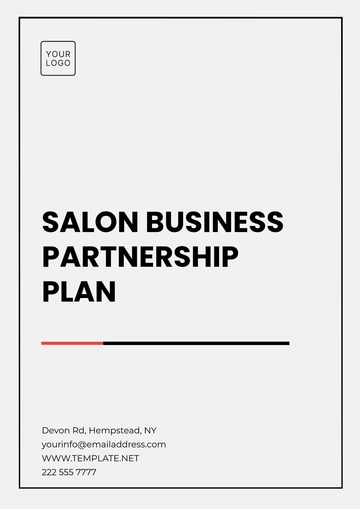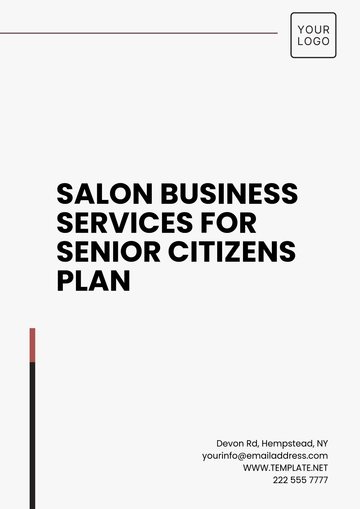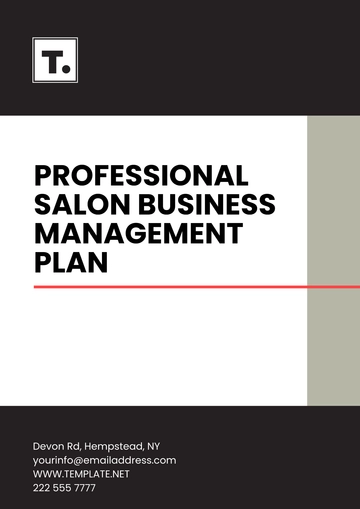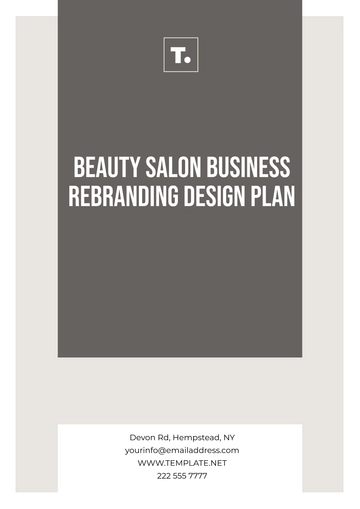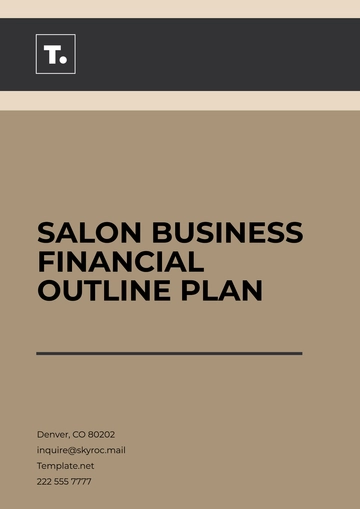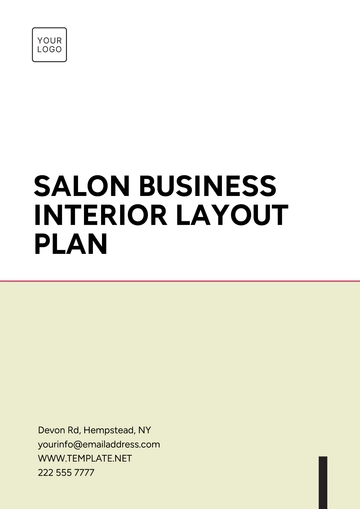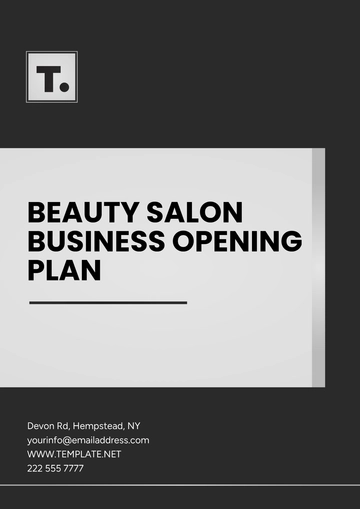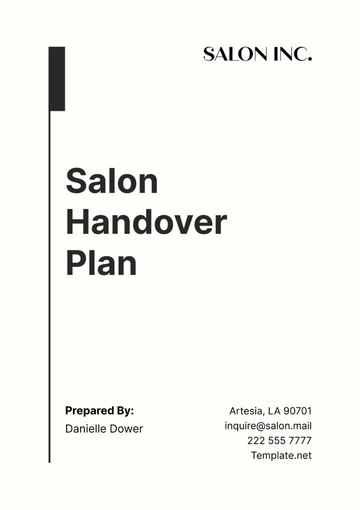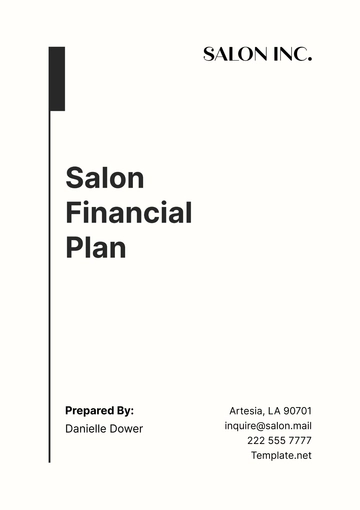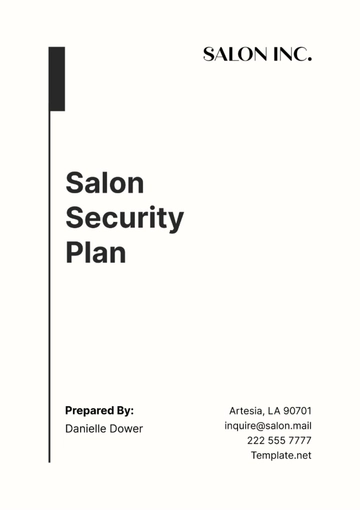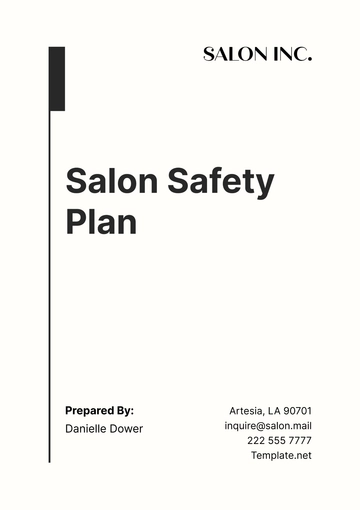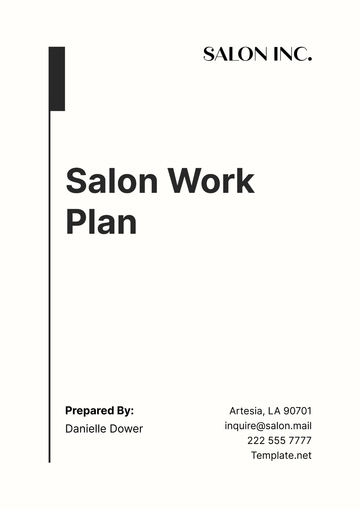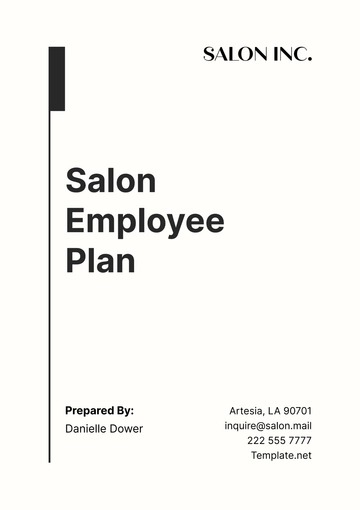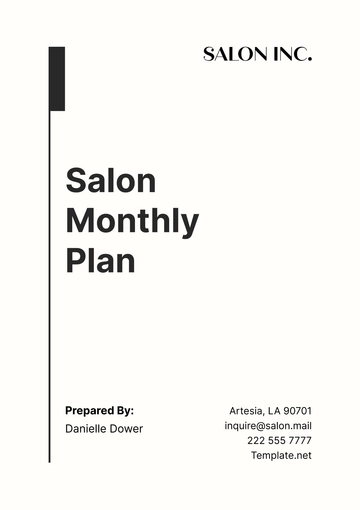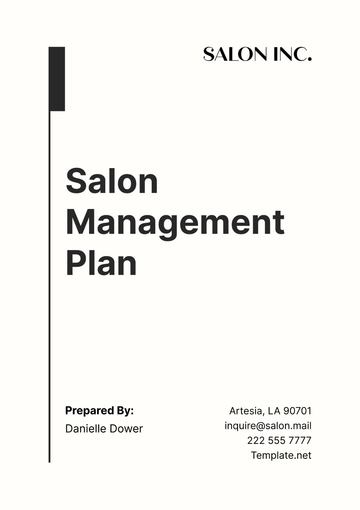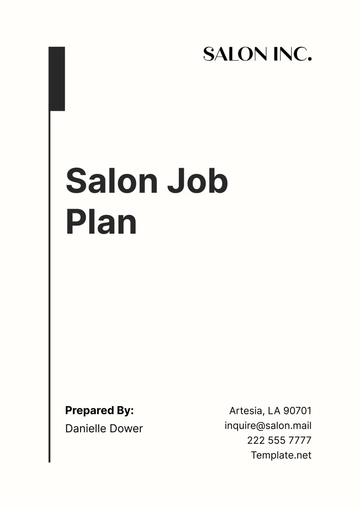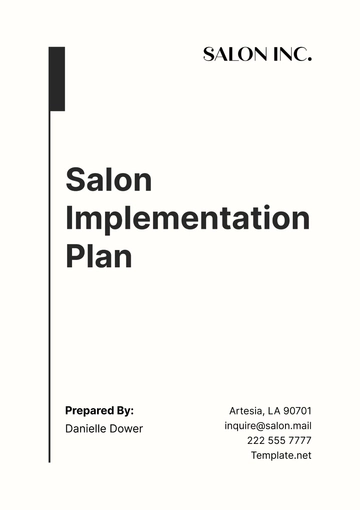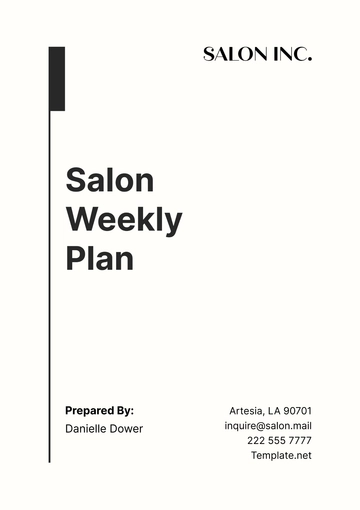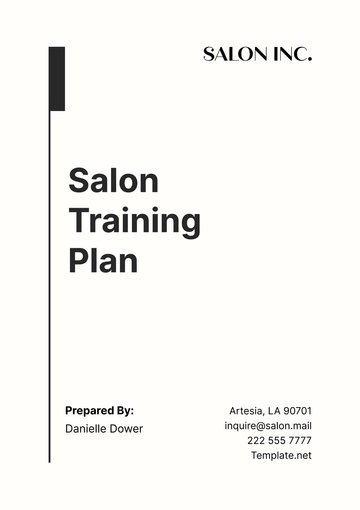Free Salon Job Plan
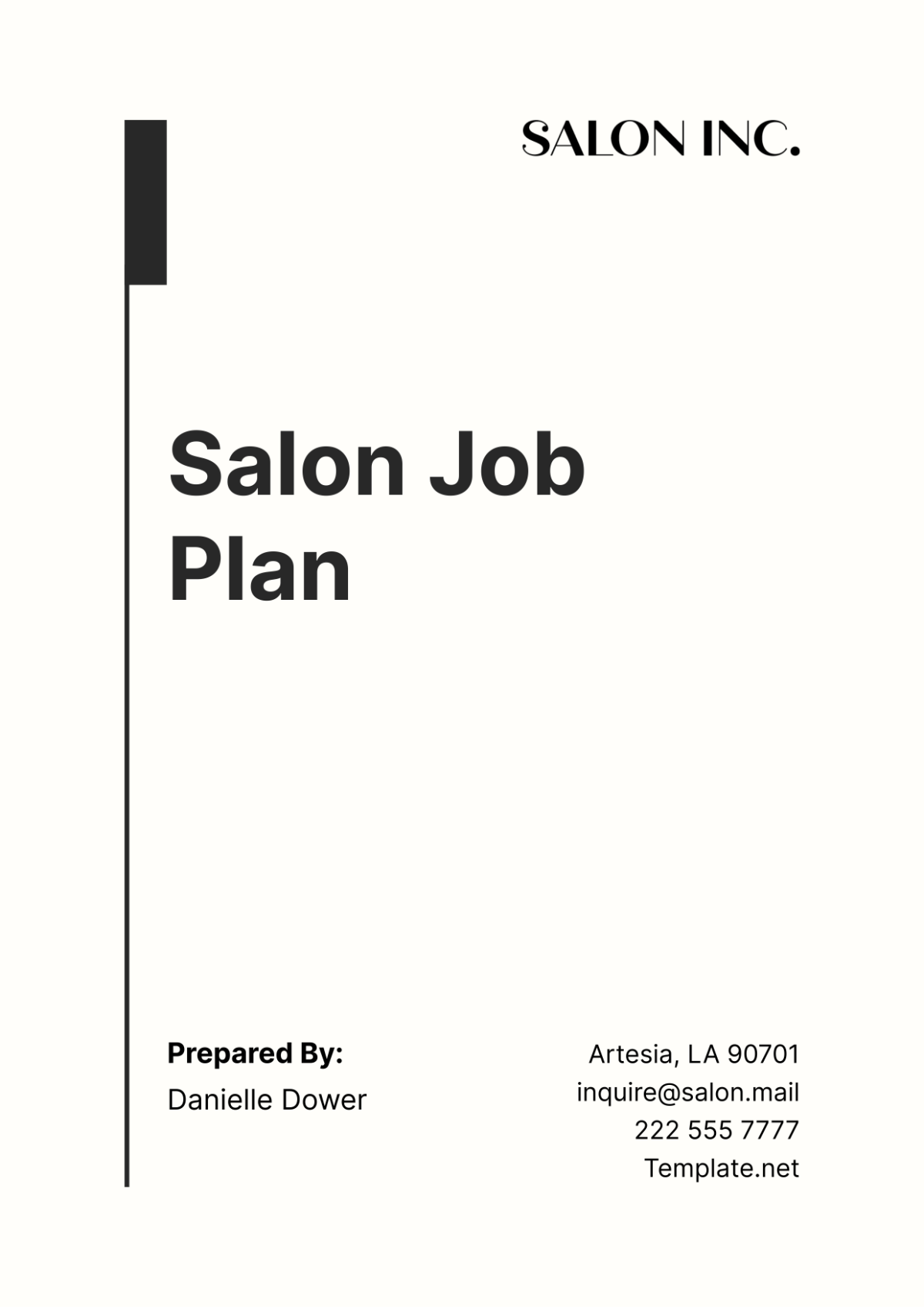
I. Introduction
A. Purpose of the Plan
The purpose of this plan are multifold:
Clarity: This plan aims to provide clarity on the roles and responsibilities of each staff member. It delineates the specific tasks associated with each role, ensuring that every employee knows what is expected of them.
Efficiency: By outlining the operational strategies, the plan helps in streamlining operations and ensuring efficient service delivery. It serves as a roadmap for the salon’s operations, guiding staff in their daily tasks and interactions with clients.
Consistency: The plan promotes consistency in service delivery across all roles. It sets the standards for service quality, ensuring that all clients receive the same high level of service regardless of who they interact with.
Training: The plan serves as a reference for training new staff members. It outlines the skills and knowledge required for each role, providing a framework for training programs.
Evaluation: The plan can be used as a basis for performance evaluation and staff development. It sets the benchmarks for performance, providing a clear basis for feedback and appraisal.
B. Scope
The scope of this plan is comprehensive, covering all aspects of salon operations:
Job Roles: The plan covers all job roles within the salon, from the Salon Manager to the Cleaning Staff. It outlines the tasks and responsibilities associated with each role, providing a clear understanding of what each job entails.
Operational Strategies: The plan includes strategies for training and development, work schedules, compensation, and benefits. These strategies are designed to ensure smooth operations and a high level of service quality.
Workplace Culture: The plan also addresses aspects of workplace culture, including team building activities, conflict resolution, and employee recognition. It aims to create a positive and supportive work environment where employees can thrive.
Recruitment Strategy: The plan outlines the strategy for recruiting new staff members. It provides guidelines for job postings, interviews, and onboarding, ensuring that the salon attracts and retains the best talent.
C. Objectives
The objectives of this plan are designed to ensure the success of [Your Company Name]:
Smooth Operations: One of the main objectives is to ensure that the salon operations run smoothly and efficiently. The plan provides the guidelines and strategies needed to achieve this.
High-Quality Service: The plan aims to maintain a high standard of service delivery to meet and exceed customer expectations. It sets the standards for service quality and provides the training and support needed to meet these standards.
Positive Workplace: The plan promotes a positive workplace environment where staff members feel valued and motivated. It includes strategies for team building, conflict resolution, and employee recognition.
Staff Development: The plan aims to provide opportunities for staff development and career progression. It includes strategies for training and development, performance evaluation, and career planning.
Customer Satisfaction: Ultimately, the plan aims to achieve high levels of customer satisfaction. It focuses on providing excellent service, responding to customer feedback, and continuously improving operations.
D. Implementation Strategy
The implementation strategy outlines how the plan will be put into action:
Communication: The plan will be communicated to all staff members to ensure everyone understands their roles and responsibilities. Regular meetings will be held to discuss the plan and address any questions or concerns.
Training: Staff members will be trained according to the guidelines outlined in the plan. Training programs will be developed to equip staff with the skills and knowledge needed to fulfill their roles effectively.
Monitoring: The implementation of the plan will be monitored to ensure it is being followed correctly. Regular checks will be conducted to assess compliance with the plan and identify any areas for improvement.
Feedback: Staff members will be encouraged to provide feedback on the plan and its implementation. This feedback will be used to refine the plan and make necessary adjustments.
Review: The plan will be reviewed regularly and updated as necessary. This ensures that the plan remains relevant and effective in guiding the salon’s operations.
Continuous Improvement: The plan promotes a culture of continuous improvement where staff members are encouraged to suggest improvements to the plan and its implementation. This fosters a proactive and innovative work environment.
II. Job Roles and Responsibilities
A. Salon Manager
The Salon Manager plays a crucial role in the smooth operation of the salon and the delivery of high-quality services to clients.
Job Description: The Salon Manager is the leader of the salon team. This role involves managing staff, ensuring high-quality service delivery, and maintaining a positive work environment. The Salon Manager is also responsible for the overall performance and profitability of the salon.
Key Responsibilities
2.1. Staff Management: This involves hiring, training, and managing all salon staff. It includes scheduling shifts, monitoring staff performance, and handling any staff-related issues.
2.2. Financial Management: This includes overseeing the salon’s finances, setting service prices, managing the salon budget, and ensuring profitability.
2.3. Customer Service: This involves ensuring that all clients receive excellent service. It includes handling client complaints and feedback, and striving to improve client satisfaction.
2.4. Compliance: This involves ensuring that the salon complies with all health and safety regulations. It also includes ensuring that the salon meets any local or state licensing requirements.
Required Skills and Qualifications
3.1. Leadership Skills: Strong leadership skills are essential for this role. The Salon Manager needs to be able to motivate and guide their team, and make decisions that benefit the salon.
3.2. Communication Skills: Excellent communication skills are essential. The Salon Manager needs to be able to clearly communicate with their team, as well as with clients.
3.3. Industry Knowledge: A thorough understanding of salon operations and the beauty industry is required. The Salon Manager should be familiar with the latest trends and techniques.
3.4. Experience and Qualifications: Relevant qualifications and experience in the beauty industry are required. This includes experience in a management role, as well as specific beauty qualifications.
B. Hair Stylists
Hair Stylists are the creative heart of the salon, providing a range of hair services to clients.
Job Description: Hair Stylists are responsible for providing hair care services to clients. This includes cutting, coloring, styling, and treating hair based on clients’ preferences and current trends.
Key Responsibilities
2.1. Client Consultation: Hair Stylists consult with clients to understand their hair care needs and preferences. They provide advice on hairstyles and hair care based on the client’s hair type, face shape, and lifestyle.
2.2. Hair Services: They provide a range of hair services, including cutting, coloring, styling, and treatments. They use a variety of tools and products to achieve the desired results.
2.3. Customer Service: Hair Stylists strive to provide excellent customer service. They aim to ensure that clients have a positive experience at the salon and are satisfied with their services.
2.4. Sanitation and Safety: They follow strict sanitation practices to ensure the safety of clients. They also adhere to all health and safety regulations related to hair services.
Required Skills and Qualifications
3.1. Technical Skills: Hair Stylists need strong technical skills in cutting, coloring, and styling hair. They should be familiar with a variety of hair types and know how to use different hair tools and products.
3.2. Creativity: Creativity is key in this role. Hair Stylists should be able to create a variety of hairstyles and adapt to the latest trends.
3.3. Communication Skills: Good communication skills are essential. Hair Stylists need to be able to listen to clients’ needs and preferences, and clearly communicate their suggestions.
3.4. Customer Service Skills: Excellent customer service skills are required. Hair Stylists should be friendly, patient, and strive to provide a positive experience for clients.
3.5. Experience and Qualifications: Relevant qualifications and experience in hair styling are required. This includes formal training in hairdressing and experience working in a salon.
C. Nail Technicians
Nail Technicians are responsible for providing nail services to clients, enhancing the beauty of their hands and feet.
Job Description: Nail Technicians provide a variety of nail services including manicures, pedicures, nail art, and nail treatments. They ensure clients’ nails are healthy, aesthetically pleasing, and well-groomed.
Key Responsibilities
2.1. Client Consultation: Nail Technicians consult with clients to understand their nail care needs and preferences. They provide advice on nail styles, colors, and treatments based on the client’s lifestyle and personal style.
2.2. Nail Services: They provide a range of nail services, including manicures, pedicures, nail art, and treatments. They use a variety of tools and products to achieve the desired results.
2.3. Customer Service: Nail Technicians strive to provide excellent customer service. They aim to ensure that clients have a positive experience at the salon and are satisfied with their services.
2.4. Sanitation and Safety: They follow strict sanitation practices to ensure the safety of clients. They also adhere to all health and safety regulations related to nail services.
Required Skills and Qualifications
3.1. Technical Skills: Nail Technicians need strong technical skills in manicures, pedicures, nail art, and nail treatments. They should be familiar with a variety of nail types and know how to use different nail tools and products.
3.2. Creativity: Creativity is key in this role. Nail Technicians should be able to create a variety of nail styles and adapt to the latest trends.
3.3. Communication Skills: Good communication skills are essential. Nail Technicians need to be able to listen to clients’ needs and preferences, and clearly communicate their suggestions.
3.4. Customer Service Skills: Excellent customer service skills are required. Nail Technicians should be friendly, patient, and strive to provide a positive experience for clients.
3.5. Experience and Qualifications: Relevant qualifications and experience in nail services are required. This includes formal training in nail care and experience working in a salon.
D. Receptionist
The Receptionist is often the first point of contact for clients and plays a vital role in creating a welcoming environment.
Job Description: The Receptionist is responsible for managing client appointments, handling inquiries, and providing excellent customer service. They play a key role in ensuring the smooth operation of the salon.
Key Responsibilities
2.1. Appointment Management: The Receptionist manages client appointments. They schedule appointments, send reminders, and handle cancellations or rescheduling requests.
2.2. Customer Service: They provide excellent customer service. They greet clients, answer their questions, and ensure they have a positive experience at the salon.
2.3. Administrative Tasks: The Receptionist also performs various administrative tasks. These may include managing client records, handling payments, and maintaining a clean and organized reception area.
2.4. Communication: They act as a liaison between clients and salon staff. They communicate client needs and preferences to the relevant staff members.
Required Skills and Qualifications
3.1. Organizational Skills: Receptionists need strong organizational skills. They manage client appointments and perform various administrative tasks, requiring them to be well-organized and detail-oriented.
3.2. Communication Skills: Good communication skills are essential. Receptionists interact with clients and salon staff, requiring them to be able to clearly communicate information.
3.3. Customer Service Skills: Excellent customer service skills are required. Receptionists should be friendly, patient, and strive to provide a positive experience for clients.
3.4. Computer Skills: Basic computer skills are required. Receptionists need to be able to use salon management software, email, and other computer applications.
E. Cleaning Staff
The Cleaning Staff plays a crucial role in maintaining the cleanliness and hygiene of the salon.
Job Description: The Cleaning Staff is responsible for keeping the salon clean and hygienic. This includes cleaning the salon area, washing towels, and sanitizing tools and equipment.
Key Responsibilities
2.1. Salon Cleaning: The Cleaning Staff is responsible for cleaning all areas of the salon. This includes sweeping and mopping floors, cleaning mirrors, and dusting furniture.
2.2. Laundry: They are responsible for washing and drying towels and other salon linens.
2.3. Sanitization: They sanitize tools and equipment used by the salon staff. This is crucial for maintaining a hygienic environment and complying with health and safety regulations.
2.4. Waste Disposal: They manage the disposal of waste in the salon, ensuring that it is done in a timely and environmentally friendly manner.
Required Skills and Qualifications
3.1. Attention to Detail: Cleaning Staff need to have a good attention to detail to ensure all areas of the salon are clean and tidy.
3.2. Physical Stamina: The role can be physically demanding, requiring the ability to stand for long periods and perform repetitive tasks.
3.3. Knowledge of Cleaning Products and Techniques: They should have knowledge of different cleaning products and techniques, and understand which to use for different tasks and materials.
3.4. Health and Safety Awareness: They should be aware of health and safety regulations related to cleaning and waste disposal.
III. Training and Development
A. Training Programs
Training programs are essential for equipping staff with the necessary skills and knowledge.
Onboarding Training: New staff members will undergo an onboarding training program. This program will introduce them to salon operations, service standards, and job responsibilities. It will also cover salon policies and procedures.
Technical Skills Training: Staff members will receive training on the technical skills required for their roles. For example, Hair Stylists will receive training on cutting, coloring, and styling techniques.
Customer Service Training: All staff members will receive customer service training. This training will focus on communication skills, handling customer complaints, and enhancing customer satisfaction.
Health and Safety Training: Staff members will receive training on health and safety regulations. This includes training on sanitation practices, safe use of equipment, and emergency procedures.
Continuous Learning: [Your Company Name] encourages continuous learning. Staff members will have opportunities to attend workshops, seminars, and industry events to keep their skills and knowledge up-to-date.
B. Skill Development
Skill development is a continuous process that helps staff members enhance their skills and performance.
Performance Reviews: Regular performance reviews will be conducted to assess staff members’ skills and performance. These reviews will identify areas of strength and areas for improvement.
Personal Development Plans: Based on the performance reviews, personal development plans will be created for each staff member. These plans will outline the skills that the staff member needs to develop and the steps they need to take to achieve this.
Mentorship Program: [Your Company Name] will implement a mentorship program. Experienced staff members will mentor new staff members, helping them develop their skills and navigate their roles.
Skill Enhancement Workshops: [Your Company Name] will organize skill enhancement workshops. These workshops will cover various topics such as advanced hair styling techniques, nail art trends, and effective customer service strategies.
C. Performance Evaluation
Performance evaluation is a critical part of staff development.
Evaluation Criteria: Performance will be evaluated based on criteria such as quality of work, customer satisfaction, teamwork, and adherence to salon policies and procedures.
Regular Feedback: Staff members will receive regular feedback on their performance. This feedback will highlight their strengths and areas for improvement.
Performance Appraisals: Formal performance appraisals will be conducted annually. These appraisals will review the staff member’s performance over the year and set goals for the next year.
Recognition and Rewards: Staff members who perform exceptionally well will be recognized and rewarded. This could include bonuses, extra time off, or other incentives.
Performance Improvement Plans: Staff members who are struggling with their performance will be put on performance improvement plans. These plans will provide support and resources to help the staff member improve.
IV. Work Schedule
The work schedule is a critical component of the Job Plan. It ensures that there are enough staff members to provide services during all operating hours. The following table outlines a sample work schedule for [Your Company Name]:
Day of the Week | Salon Manager | Hair Stylists | Nail Technicians | Receptionist | Cleaning Staff |
|---|---|---|---|---|---|
Monday | 9am - 5pm | 10am - 6pm | 11am - 7pm | 9am - 5pm | After Hours |
Tuesday | 9am - 5pm | 10am - 6pm | 11am - 7pm | 9am - 5pm | After Hours |
Wednesday | 9am - 5pm | 10am - 6pm | 11am - 7pm | 9am - 5pm | After Hours |
Thursday | 9am - 5pm | 10am - 6pm | 11am - 7pm | 9am - 5pm | After Hours |
Friday | 9am - 5pm | 10am - 6pm | 11am - 7pm | 9am - 5pm | After Hours |
Saturday | Off | 10am - 6pm | 11am - 7pm | 9am - 5pm | After Hours |
Sunday | Off | Off | Off | Off | After Hours |
The work schedule is designed to ensure that there is adequate staff coverage during all operating hours. It takes into account the different roles within the salon and their specific responsibilities. For example, the Salon Manager starts earlier to prepare for the day and handle administrative tasks, while the Hair Stylists and Nail Technicians start later when clients begin to arrive.
The schedule also includes after-hours cleaning to ensure that the salon is clean and ready for the next day. The Cleaning Staff works after the salon closes to avoid disrupting salon operations during business hours.
Factors such as peak hours, staff availability, and client preferences can influence the final work schedule. Regular reviews and adjustments of the work schedule can help ensure optimal staff coverage and client satisfaction.
V. Compensation and Benefits
A. Salary Structure
The salary structure outlines the compensation for each role within the salon, ensuring that staff members are fairly compensated for their skills and efforts. The following table provides the salary structure for [Your Company Name]:
Role | Monthly Salary |
|---|---|
Salon Manager | $4,166.67 |
Hair Stylists | $2,916.67 |
Nail Technicians | $2,500.00 |
Receptionist | $2,083.33 |
Cleaning Staff | $1,666.67 |
The Salon Manager, being the leader of the team, has the highest salary reflecting the level of responsibility and expertise the role requires. They oversee the entire operations of the salon, manage the staff, and ensure customer satisfaction, which justifies their compensation.
Hair Stylists and Nail Technicians, being the service providers, have salaries that reflect their technical skills and the direct revenue they bring to the salon. Their compensation is designed to reward their craftsmanship and customer service skills.
The Receptionist, while not directly providing beauty services, plays a crucial role in managing client appointments and providing excellent customer service. Their salary reflects the importance of their role in ensuring smooth salon operations.
The Cleaning Staff, while often overlooked, plays a vital role in maintaining the cleanliness and hygiene of the salon. Their compensation recognizes the importance of their role in providing a clean and comfortable environment for both clients and staff.
This salary structure ensures that all staff members are fairly compensated for their contributions to the salon. It’s important to note that this is a sample salary structure and can be adjusted based on the specific needs and budget of [Your Company Name]. Regular reviews and adjustments of the salary structure can help ensure that it remains competitive and fair.
B. Incentives and Bonuses
Incentives and bonuses are a key part of the compensation structure at [Your Company Name]. They are designed to motivate staff members and reward them for their hard work and dedication. The following table outlines the incentives and bonuses offered:
Role | Incentive | Bonus |
|---|---|---|
Salon Manager | 10% of the total monthly profit | $500 for exceptional performance |
Hair Stylists | 5% commission on product sales | $200 for achieving monthly targets |
Nail Technicians | 5% commission on product sales | $200 for achieving monthly targets |
Receptionist | N/A | $100 for exceptional customer service |
Cleaning Staff | N/A | $100 for maintaining exceptional cleanliness |
The Salon Manager, as the leader of the team, has the opportunity to earn a significant incentive based on the salon’s monthly profit. This encourages them to drive the salon’s profitability and manage the operations effectively. The bonus for exceptional performance serves as a reward for going above and beyond in their role.
Hair Stylists and Nail Technicians, being the service providers, have the opportunity to earn a commission on the products they sell. This encourages them to recommend suitable products to clients, enhancing the client’s experience and driving product sales. The bonus for achieving monthly targets serves as a motivation to consistently deliver high-quality services and maintain a steady client base.
While the Receptionist and Cleaning Staff do not have a commission-based incentive, they are eligible for a bonus for exceptional performance. For the Receptionist, this could be for providing exceptional customer service, and for the Cleaning Staff, this could be for maintaining exceptional cleanliness in the salon.
Incentives and bonuses play a crucial role in motivating staff members and enhancing their job satisfaction. They not only provide financial rewards but also recognize the efforts and contributions of staff members. By aligning the incentives and bonuses with the salon’s goals, [Your Company Name] can drive performance and ensure the delivery of high-quality services.
It’s important to note that the incentives and bonuses should be reviewed regularly to ensure they remain competitive and continue to motivate staff members. They should also be clearly communicated to all staff members so they understand how they can achieve these rewards.
C. Health and Wellness Benefits
Health and wellness benefits are an integral part of the compensation structure at [Your Company Name]. They contribute to the overall well-being of the staff, promoting a healthy work environment. The following table outlines the health and wellness benefits offered:
Benefit | Description |
|---|---|
Health Insurance | Comprehensive health insurance coverage |
Dental Insurance | Coverage for dental care |
Vision Insurance | Coverage for eye care and eyewear |
Wellness Program | Programs to promote physical and mental health |
Employee Assistance Program | Support for personal and work-related issues |
Gym Membership | Subsidized or fully paid gym membership |
Health insurance provides comprehensive coverage for medical expenses. This ensures that staff members can receive necessary medical care without financial burden. It’s a crucial benefit that provides peace of mind for staff members and their families.
Dental and vision insurance coverages are also provided. These coverages ensure that staff members can maintain their oral and visual health. Regular dental and eye check-ups can prevent serious health issues and improve the quality of life.
The wellness program and the employee assistance program are designed to support the physical and mental health of the staff members. The wellness program may include activities such as yoga classes, health workshops, and regular health check-ups. The employee assistance program provides support for personal and work-related issues, including counseling services.
The gym membership is a great perk that encourages staff members to stay active and fit. Regular exercise can improve physical health, boost mood, and increase energy levels.
These health and wellness benefits not only contribute to the well-being of the staff members but also demonstrate [Your Company Name]'s commitment to its staff. By investing in the health and wellness of its staff, [Your Company Name] can improve staff satisfaction, reduce absenteeism, and increase productivity.
It’s important to note that these benefits should be reviewed regularly to ensure they meet the needs of the staff and remain competitive. Regular feedback from staff members can provide valuable insights into how these benefits can be improved.
VI. Workplace Culture
A. Team Building Activities
Team building activities are essential for fostering a sense of camaraderie and teamwork among staff members.
Regular Team Meetings: Regular team meetings provide an opportunity for staff members to communicate, collaborate, and build relationships. They can also be used to discuss salon operations, address issues, and share ideas.
Team Outings: Team outings such as dinners, picnics, or recreational activities can help staff members bond outside of the work environment. These outings can foster a sense of camaraderie and improve team dynamics.
Training Workshops: Training workshops not only enhance staff skills but also provide an opportunity for team building. Staff members can learn together, share knowledge, and support each other’s development.
Celebrations: Celebrating staff birthdays, work anniversaries, and achievements can boost morale and create a positive work environment. It shows appreciation for staff members and acknowledges their contributions to the salon.
Team Challenges: Team challenges such as competitions or goal-oriented tasks can foster teamwork and collaboration. They can also make the work environment more fun and engaging.
B. Conflict Resolution
Conflict resolution is crucial for maintaining a positive and productive work environment.
Open Communication: Encouraging open communication can prevent misunderstandings and conflicts. Staff members should feel comfortable expressing their thoughts, ideas, and concerns.
Conflict Resolution Policy: Having a clear conflict resolution policy can help manage conflicts effectively. The policy should outline the steps for addressing conflicts and the resources available for staff members.
Mediation: In case of conflicts, mediation can be a useful tool. A neutral third party can facilitate a discussion between the conflicting parties and help them find a resolution.
Training: Providing conflict resolution training can equip staff members with the skills to manage conflicts effectively. It can help them understand different perspectives, communicate effectively, and find win-win solutions.
C. Employee Recognition
Employee recognition is important for acknowledging the efforts and achievements of staff members.
Recognition Program: Implementing a recognition program can motivate staff members and boost morale. The program can include things like ‘Employee of the Month’ awards or recognition for achieving certain milestones.
Positive Feedback: Regularly providing positive feedback can make staff members feel valued and appreciated. It can boost their morale and motivation.
Rewards: Rewards such as bonuses, extra time off, or small gifts can be a tangible way to recognize staff members’ efforts and achievements.
Public Recognition: Publicly recognizing staff members’ achievements can boost their morale and motivation. This could be done during team meetings or through a recognition board in the salon.
Career Advancement Opportunities: Providing opportunities for career advancement can be a powerful way to recognize and reward high-performing staff members. It shows that their efforts are recognized and that they have a future at the salon.
D. Work-Life Balance
Promoting work-life balance is important for staff well-being and job satisfaction.
Flexible Scheduling: Offering flexible scheduling can help staff members balance their work and personal life. This could include options for part-time work, flexible hours, or job sharing.
Time Off: Providing adequate time off for rest and relaxation is crucial for staff well-being. This includes annual leave, sick leave, and breaks during the workday.
Wellness Programs: Wellness programs can support staff well-being. This could include things like yoga classes, stress management workshops, or health screenings.
Support for Personal Issues: Providing support for personal issues can help staff members manage their personal life without it affecting their work. This could include counseling services or referrals to relevant support services.
Respect for Personal Time: Respecting staff members’ personal time can help them achieve work-life balance. This means avoiding contacting staff members outside of work hours unless it’s absolutely necessary.
Healthy Work Environment: Creating a healthy work environment can contribute to work-life balance. This includes ensuring a safe and comfortable workspace, promoting a positive work culture, and providing resources for staff well-being.
VII. Recruitment Strategy
A. Job Postings
Job postings are the primary means of attracting potential candidates.
Job Description: Each job posting will include a comprehensive job description. This will outline the role, responsibilities, required skills and qualifications, and any other relevant information.
Advertising Channels: Job postings will be advertised through various channels. This could include online job boards, social media, the salon’s website, and local community boards.
Branding: The job postings will reflect the salon’s brand. They will be professionally written and designed, and convey the salon’s values and culture.
Equal Opportunity Statement: Each job posting will include an equal opportunity statement. This will affirm the salon’s commitment to diversity and inclusion.
Application Instructions: The job postings will provide clear instructions on how to apply. This will ensure a smooth application process for potential candidates.
B. Interview Process
The interview process is crucial for assessing potential candidates.
Screening: Initial screening of applications will be conducted to shortlist potential candidates. This will be based on their qualifications, experience, and fit with the job requirements.
Interviews: Shortlisted candidates will be invited for interviews. The interviews will assess the candidates’ skills, experience, and fit with the salon’s culture.
Practical Assessment: For roles such as Hair Stylists and Nail Technicians, a practical assessment may be included in the interview process. This will allow candidates to demonstrate their technical skills.
Reference Checks: Reference checks will be conducted for final-stage candidates. This will provide additional insights into the candidates’ capabilities and work ethic.
C. Onboarding Process
The onboarding process is important for integrating new staff members into the salon.
Orientation: New staff members will undergo an orientation program. This will introduce them to the salon’s operations, policies, and culture.
Training: New staff members will receive training to equip them with the necessary skills and knowledge for their role.
Mentorship: New staff members may be paired with a mentor. The mentor will provide guidance and support as they navigate their new role.
Performance Feedback: New staff members will receive regular performance feedback. This will help them understand their strengths, areas for improvement, and progress in their role.
Probation Period: New staff members may have a probation period. This will allow both the salon and the staff member to assess their fit with the role and the salon.
VIII. Conclusion
This Job Plan for [Your Company Name] provides a comprehensive framework for managing the salon’s operations, staff, and finances. It outlines the roles and responsibilities of each staff member, the training and development strategies, the work schedule, the compensation and benefits structure, the workplace culture, and the recruitment strategy. Each of these components plays a crucial role in ensuring the smooth operation of the salon, the delivery of high-quality services, and the satisfaction of both staff and clients.
The plan recognizes that the success of [Your Company Name] relies not only on the skills and expertise of its staff but also on the work environment, the operational strategies, and the financial management. By providing clear guidelines and strategies in these areas, the plan aims to equip [Your Company Name] with the tools it needs to thrive in the competitive beauty industry.
- 100% Customizable, free editor
- Access 1 Million+ Templates, photo’s & graphics
- Download or share as a template
- Click and replace photos, graphics, text, backgrounds
- Resize, crop, AI write & more
- Access advanced editor
Streamline workforce planning with our Salon Job Plan Template only at Template.net! This versatile and editable resource offers a structured framework for outlining staffing requirements and roles within the salon. With its customizable format and AI Editor Tool, you can adapt it to reflect your needs facilitating recruitment and talent management!
You may also like
- Finance Plan
- Construction Plan
- Sales Plan
- Development Plan
- Career Plan
- Budget Plan
- HR Plan
- Education Plan
- Transition Plan
- Work Plan
- Training Plan
- Communication Plan
- Operation Plan
- Health And Safety Plan
- Strategy Plan
- Professional Development Plan
- Advertising Plan
- Risk Management Plan
- Restaurant Plan
- School Plan
- Nursing Home Patient Care Plan
- Nursing Care Plan
- Plan Event
- Startup Plan
- Social Media Plan
- Staffing Plan
- Annual Plan
- Content Plan
- Payment Plan
- Implementation Plan
- Hotel Plan
- Workout Plan
- Accounting Plan
- Campaign Plan
- Essay Plan
- 30 60 90 Day Plan
- Research Plan
- Recruitment Plan
- 90 Day Plan
- Quarterly Plan
- Emergency Plan
- 5 Year Plan
- Gym Plan
- Personal Plan
- IT and Software Plan
- Treatment Plan
- Real Estate Plan
- Law Firm Plan
- Healthcare Plan
- Improvement Plan
- Media Plan
- 5 Year Business Plan
- Learning Plan
- Marketing Campaign Plan
- Travel Agency Plan
- Cleaning Services Plan
- Interior Design Plan
- Performance Plan
- PR Plan
- Birth Plan
- Life Plan
- SEO Plan
- Disaster Recovery Plan
- Continuity Plan
- Launch Plan
- Legal Plan
- Behavior Plan
- Performance Improvement Plan
- Salon Plan
- Security Plan
- Security Management Plan
- Employee Development Plan
- Quality Plan
- Service Improvement Plan
- Growth Plan
- Incident Response Plan
- Basketball Plan
- Emergency Action Plan
- Product Launch Plan
- Spa Plan
- Employee Training Plan
- Data Analysis Plan
- Employee Action Plan
- Territory Plan
- Audit Plan
- Classroom Plan
- Activity Plan
- Parenting Plan
- Care Plan
- Project Execution Plan
- Exercise Plan
- Internship Plan
- Software Development Plan
- Continuous Improvement Plan
- Leave Plan
- 90 Day Sales Plan
- Advertising Agency Plan
- Employee Transition Plan
- Smart Action Plan
- Workplace Safety Plan
- Behavior Change Plan
- Contingency Plan
- Continuity of Operations Plan
- Health Plan
- Quality Control Plan
- Self Plan
- Sports Development Plan
- Change Management Plan
- Ecommerce Plan
- Personal Financial Plan
- Process Improvement Plan
- 30-60-90 Day Sales Plan
- Crisis Management Plan
- Engagement Plan
- Execution Plan
- Pandemic Plan
- Quality Assurance Plan
- Service Continuity Plan
- Agile Project Plan
- Fundraising Plan
- Job Transition Plan
- Asset Maintenance Plan
- Maintenance Plan
- Software Test Plan
- Staff Training and Development Plan
- 3 Year Plan
- Brand Activation Plan
- Release Plan
- Resource Plan
- Risk Mitigation Plan
- Teacher Plan
- 30 60 90 Day Plan for New Manager
- Food Safety Plan
- Food Truck Plan
- Hiring Plan
- Quality Management Plan
- Wellness Plan
- Behavior Intervention Plan
- Bonus Plan
- Investment Plan
- Maternity Leave Plan
- Pandemic Response Plan
- Succession Planning
- Coaching Plan
- Configuration Management Plan
- Remote Work Plan
- Self Care Plan
- Teaching Plan
- 100-Day Plan
- HACCP Plan
- Student Plan
- Sustainability Plan
- 30 60 90 Day Plan for Interview
- Access Plan
- Site Specific Safety Plan
